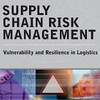 A posting on Evolving Excellence called Long is not Lean caught my attention the other day. The author was lamenting over an article in Logistics Management that talked at length about the Downside of Lean Logistics and how lean means a supply chain that is more prone to risks and disruptions. Naturally, since Evolving Excellence is all about “Thoughts on Lean Enterprise Leadership”, of course they stood up for lean and defended it vigorously, and thinking about it, I have to agree that it is true, a lean supply chain is not necessarily a risky supply chain.
A posting on Evolving Excellence called Long is not Lean caught my attention the other day. The author was lamenting over an article in Logistics Management that talked at length about the Downside of Lean Logistics and how lean means a supply chain that is more prone to risks and disruptions. Naturally, since Evolving Excellence is all about “Thoughts on Lean Enterprise Leadership”, of course they stood up for lean and defended it vigorously, and thinking about it, I have to agree that it is true, a lean supply chain is not necessarily a risky supply chain.
Lean = risky?
The article in Evolving Excellence, written by Patrick Burnson, is actually referring to a report on Risk Management in International Transport and Logistics published by Drewry Shipping Consultants. Unfortunately, the full report is only available for the “small” price of £950, so I cannot comment on Burnson’s comments on the report, only on the presentation brochure for the report. As an academic, I could not help but notice this statement in the press release for the report:
Contrary to many reports and academic studies into supply chain risk management, Drewry’s report but does not look specifically at the risks of procuring and sourcing raw materials and finished products, but at the risks involved in purchasing and managing international logistics and transport, and associated risks on availability and control of inventory. (text sections highlighted by me)
In defense it must be said that there is, to say the least, ample academic research on global supply chains and their implications, and on inventory. Where the report may be right though is that international sourcing has introduced in global business more and higher risks related to transport and logistics, and that these risks are often more complex and more significant than in the past.
Lean = vulnerable?
What Burnson suggests is that international supply chains have an inherent flaw:
…the dilemma with lean international supply chains, coupled to lean manufacturing, is that they can become more vulnerable to risk factors. If the supply chain becomes longer (due to outsourcing the supply or manufacture) this vulnerability can increase…
Right. But is that necessary true? In the chapter on Supply Chain Risk in his recent book on Logistics and Supply Chain Management, Martin Christopher list the following reasons for increased supply chain vulnerability:
- The trend towards just-in-time and lean practices
- efficiency rather than effectiveness.
- The trend towards reducing costs (at almost any cost)
- globalization of supply chains, more complex and vulnerable.
- The trend towards economies of scale (centralized distribution and manufacturing)
- lower costs but at the same time less flexibility
- The trend towards outsourcing non-core business activities
- loss of control of the supply chain when it is most needed
- The trend towards consolidation of suppliers (intentional and incidental mergers and acquisitions)
- increased potential for supply failure
Obviously, “lean” is only one of many reasons.
Lean = not robust, flexible, agile, or resilient?
In his defense reply to the article in Logistics Management, Kevin Meyer of Evolving Excellence states that
A “lean” supply chain that falls apart due to disruption is not a robust supply chain, lean or otherwise. Robust does not necessarily mean inventory buffers, but could include internal agility to adjust product mix to a change in incoming raw material sequencing, additional backup suppliers, assembly alternatives, and the like.
Exactly. This brings to mind one of my own articles on robustness, flexibility and resilience. Robustness, flexibility, agility and resilience stand out as four strategies or approaches towards supply chain disruptions. These four terms are distinctively different and which strategy that works best would depend not only on the supply chain in question as a whole, but also which part of the supply chain that may be vulnerable. A best-practice supply chain is likely to encompass all four, making it robust, flexible, agile and resilient at the same time. Is lean logistics the same as risky logistics? No, lean does not necessarily make you more vulnerable or less robust towards supply chain disruptions. Lean implies agile, and agile is what is needed to overcome supply chain disruptions.
Personally, I fail to see the immediate connection between lean and vulnerable. In fact, lean and agile go very well together: Leagile.
Links
- Evolving Excellence: Long is not Lean
- drewry.co.uk: Risk Management in International Transport and Logistics
Related
- husdal.com: Lean + Agile = Leagile
- husdal.com: De-confusing robustness, resilience, flexibility and agility











